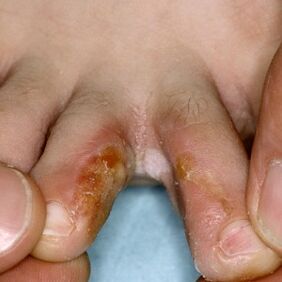According to dermatologists, mycoses, including fungi between the fingers, develop against the background of weakened immunity. The skin on the feet, and especially between the toes, is susceptible to the negative impact of footwear and lack of personal hygiene. These factors make it susceptible to fungal infection. Cracks, microabrasions, abrasions, blisters, etc. predispose to the occurrence of fungus on the fingers. Sweaty feet play an important role in the development of this unpleasant disease, which is important for young people. In elderly people, fungi appear between the toes for reasons related to diseases of the extremities, metabolic disorders, etc. Overweight people are particularly susceptible to foot mycosis.

Symptoms of fungus between the toes
Mycoses of the lower extremities begin with an interdigital fungus, which then spreads to other areas. Symptoms of toenail fungus vary. The number of signs of the disease depends on its stage. In the first stage there are several signs. They manifest as redness between the fingers and itching. Then, if the infection is not stopped, symptoms develop further. Bubbles appear, burst and form cracks. They can get wet and cause pain. When bacterial flora accumulates at the site of cracks, weeping ulcers appear. Fungus between the toes is characterized by severe itching. When the blisters are scratched, the infection spreads further. This is what nail fungus looks like between your toes.
Interdigital fungus on the toes is almost always combined with onychomycosis, a fungus of the nail plate. Fungi slowly but steadily progress into the healthy parts of the skin of the feet. The acute form without appropriate and timely treatment becomes chronic. The surface of the feet and the spaces between the toes become rough and take on a yellowish-dirty color.
Diagnosis of interdigital fungi
Before determining how to treat nail fungus between the toes, it is necessary to diagnose them. Recognizing mycosis of the feet is not difficult for a specialist. It is enough to examine the skin between the fingers and notice the signs characteristic of this disease. In order to find out how to treat fungus between the fingers and what type of fungal flora lives on the patient's skin, a scraping is taken from the affected areas and sent to the laboratory. Inoculation of fungal spores allows you to accurately determine the cause of the disease, and then choose the most effective methods and means of future treatment.
Treatment
The treatment of fungi between the fingers, as well as other areas, should be carried out in a complex way. It includes the following types of treatment:
- local;
- anti-inflammatory;
- antibacterial;
- systemic.
Local therapy
Local therapy is effective in the initial stages of the disease. First, the doctor selects antimycotic drugs. They are effective when the infection has not yet spread beyond the interdigital space. Today, the market of such drugs is quite wide, which allows effective treatment of fungus between the toes. But self-treatment of the disease even in the initial stage is risky, due to the wrong choice of medicine, which may not solve the problem, but may make it worse. Only a dermatologist can choose and prescribe local antimycotics. Well-proven dosage forms are ointments and creams. They should be applied in a thin layer to the interdigital space, covering cracks and ulcers. It is imperative to treat areas that are not affected by the fungus to prevent further spread of the infection.
Which dosage form is better - ointment or cream? It is preferable to use the ointment on scaly, dry areas. It is convenient to use under bandages for better penetration into the lower layers of the dermis. The cream is recommended for use in the stage of more pronounced symptoms of the disease. It is used for weeping and erosive ulcers between the fingers. As a rule, ointments and creams are also prescribed. The ointment is applied to the affected areas at night. It is better to use the cream during the day.
Before using ointments and creams, the feet must be prepared - thoroughly washed with antibacterial soap and dried.
Anti-inflammatory therapy
Inflammatory phenomena on the affected areas can be treated with foot baths. A good effect is given by baths with a slightly pink manganese solution. Such baths dry up weeping ulcers and relieve inflammation around them. After the bath, ointments with glucocorticosteroids are applied to the legs.
Treatment of bacterial infection
An unpleasant smell from the feet indicates a layer of bacterial infection and fungus between the toes. Treatment of a complicated form of foot fungus involves the prescription of combined drugs with antibiotics.
Systemic treatment of fungi with tablets
In patients with diabetes, diseases of the blood vessels of the legs and those who have taken antibiotics for a long time, treatment with local drugs may be ineffective. In such cases, systemic therapy is used. Most often, these are drugs from the triazole group.
These drugs are strictly prescribed by a specialist doctor for serious indications. They have limitations, because their use is associated with side effects in the form of dysbiosis, dyspeptic disorders, impaired functioning of the kidneys and liver, etc. The course of systemic therapy prescribed by the doctor cannot be interrupted without sufficient reason. Interrupted treatment can lead to resistance to numerous drugs, primarily antibiotics.

Folk remedies
Traditional medicine is also used to treat foot fungus. They can give a good effect in the initial stage of the disease, relieve symptoms such as itching and redness.
One of the proven remedies is kombucha.
Kombucha treatment
Its effectiveness is explained by the large composition of substances included in it and vinegar. Grind a small piece of old kombucha, washed well in water, and rub it into the interdigital space. You can use kombucha for a month. Repeat the treatment as prophylaxis after two weeks.
Tincture of propolis
Another medicine that is popular in folk medicine is propolis tincture. It has strong anti-inflammatory, antimicrobial and antifungal effects. A cotton swab or bandage moistened with propolis tincture is squeezed out and placed between the fingers. You should wear cotton socks on top and leave it all night. The course of treatment is 15-20 days. Since the tincture is alcohol-based, after removing the lotion, the feet should be smeared with a nourishing cream.

Celandine juice
A powerful remedy for the initial stage of fungus between the toes is celandine flower juice. To get it, simply crush the green parts of the plant and squeeze out the juice. It is used as an independent remedy that can simply be used to lubricate skin areas damaged by fungi. With daily use of celandine juice, the uninfected fungus disappears within 2 weeks.
Foot baths
Apple cider vinegar baths have a good healing effect. Add 2 cups of apple cider vinegar to 2 quarts of warm water. And keep your feet in the bath for 25-30 minutes. After the bath, remove the dead skin between the fingers and apply the healing ointment.
Vinegar baths can be alternated with celandine baths.
Prevention of foot fungus between the toes
Although yeast infections are common, they can be avoided. Following simple recommendations will help prevent yeast infection:
- observe the rules of personal hygiene. Washing your feet daily with antibacterial soap will help prevent excessive sweating. To prevent burns on your feet, you should not wear tight, uncomfortable shoes. From time to time it is necessary to disinfect the shoes;
- When visiting public saunas, baths and swimming pools, you must wear special footwear;
- keep the bathtub clean by regular disinfection with cleaning agents and warm water;
- Items for personal hygiene - washcloths and sponges - should be regularly treated with disinfectant solutions. Never use other people's cloths and sponges;
- monitor the condition of your feet. For care, use special creams that contain components that prevent the development of fungal infections.
And of course, we must not forget about strengthening the immune system. After all, mycotic infections, including toenail fungus between the toes, occur in those people whose immunity cannot cope with fungi whose spores are constantly around us. And only people with a weakened immune system develop fungal diseases.
















